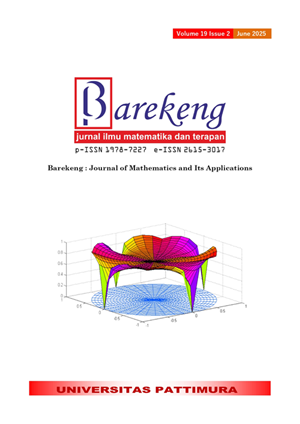COMPARISON FORECASTING BETWEEN SINGULAR SPECTRUM ANALYSIS AND LOCAL LINEAR METHOD FOR SHIP ACCIDENT SEARCH AND RESCUE OPERATIONS IN INDONESIA
Abstract
As a maritime country strategically located along the world's leading transportation routes, Indonesia often faces increased ship accidents. Based on the Basarnas Statistics Book, ship accidents handled by Basarnas from 2021 to 2023 increased by 3%. This condition requires an effective forecasting method to carry out SAR operations to predict ship accidents in the Indonesian region in the future and assess the readiness and needs of Basarnas resources. This study compares the forecasting results obtained using the Singular Spectrum Analysis (SSA) and the Local Linear methods. Both methods do not require parametric assumptions. The data used in this study are divided into training data and test data. This data is secondary data obtained from the Basarnas Statistics Book. The training data in this study is the number of SAR operations from January 2021 to December 2022, while the testing data is from January 2023 to December 2023. From the analysis results, it is known that the method with the smallest MAPE is the Local Linear method with a MAPE of test data of 18.67% (good forecasting category), optimal bandwidth (h) = 4.299, and CV (h) = 231.39 where bandwidth is used to determine the level of smoothness of the estimate, while the CV (h) value is used to select the optimal bandwidth that minimizes the estimation error. At the same time, the SSA method has a MAPE of 40.27% (fair forecasting category). This shows that the Local Linear method provides a more accurate forecast of the number of SAR operations related to ship accidents in Indonesia. This research contributes to the SDGs to make Basarnas an effective and accountable institution and improve the planning and decision-making process in SAR operations through accurate forecasting research is relevant to accurate forecasting.
Downloads
References
S. Sadya, "INDONESIA HAS 17,001 ISLANDS IN 2022, WHERE ARE THE MOST PLACES?," Dataindonesia.id. [Online]. Available: https://dataindonesia.id/varia/detail/indonesia-punya-17001-pulau-pada-2022-paling-banyak-di-mana
Jing Wang, Xuhong Peng, Jindong Wu, Youde Ding, Barkat Ali, Yizhou Luo, Yiting Hu, Keyao Zhang, SINGULAR SPECTRUM ANALYSIS (SSA) BASED HYBRID MODELS FOR EMERGENCY AMBULANCE DEMAND (EAD) TIME SERIES FORECASTING, IMA Journal of Management Mathematics, Volume 35, Issue 1, January 2024, Pages 45–64
S. I. Christienova, E. W. Pratiwi, and G. Darmawan, "COMPARISON OF SINGULAR SPECTRUM ANALYSIS (SSA) AND FOURIER SERIES ANALYSIS (FSA) FORECASTING MODELS ON AIR TEMPERATURE DATA IN SURABAYA," Berk. MIPA, vol. 25, no. 1, pp. 94–106, 2018.
Aizenbud, Yariv & Sober, Barak. (2021). CONVERGENCE RATES OF VECTOR-VALUED LOCAL POLYNOMIAL REGRESSION. 10.48550/arXiv.2107.05852.
Emmenegger, Corinne & Bühlmann, Peter. (2021). DOUBLE MACHINE LEARNING FOR PARTIALLY LINEAR MIXED-EFFECTS MODELS WITH REPEATED MEASUREMENTS. 10.48550/arXiv.2108.13657.
S. Suparti and A. Prahutama, "NONPARAMETRIC REGRESSION MODELING USING A LOCAL POLYNOMIAL APPROACH ON ELECTRICAL LOAD IN SEMARANG CITY," Media Stat., vol. 9, no. 2, pp. 85–93, 2016.
S. M. Sun MingDong and L. X. Li XuYong, “WINDOW LENGTH SELECTION OF SINGULAR SPECTRUM ANALYSIS AND APPLICATION TO PRECIPITATION TIME SERIES.,” 2017.
S. M. Sun MingDong and L. X. Li XuYong, “WINDOW LENGTH SELECTION OF SINGULAR SPECTRUM ANALYSIS AND APPLICATION TO PRECIPITATION TIME SERIES.,” 2017.
S. Satriani and R. Ibnas, "FORECASTING THE CONSUMER PRICE INDEX (CPI) IN SOUTH SULAWESI USING THE SINGULAR SPECTRUM ANALYSIS (SSA) METHOD," J. MSA (Mathematics and Stat. and Apl., vol. 8, no. 1, pp. 82–89, 2020.
Nguyen, Anh & Nguyen, Phi Le & Vu, Viet & Pham, Quoc & Nguyen, Viet & Nguyen, Minh & Nguyen, Hùng & Nguyen, Kien. (2022). ACCURATE DISCHARGE AND WATER LEVEL FORECASTING USING ENSEMBLE LEARNING WITH GENETIC ALGORITHM AND SINGULAR SPECTRUM ANALYSIS-BASED DENOISING. SCIENTIFIC REPORTS. 12. 10.1038/s41598-022-22057-8.
S. Wadekar, A. Mahalkari, A. Ali and A. Gupta, "A REVIEW ON SINGULAR SPECTRUM ANALYSIS," 2022 IEEE INTERNATIONAL CONFERENCE ON CURRENT DEVELOPMENT IN ENGINEERING AND TECHNOLOGY (CCET), Bhopal, India, 2022, pp. 1-6, doi: 10.1109/CCET56606.2022.10080082.
G. Darmawan, "IDENTIFICATION OF RAINFALL DATA PATTERNS IN THE GROUPING PROCESS IN THE SINGULAR SPECTRUM ANALYSIS METHOD," 2016.
Nur Chamidah , Budi Lestari, ANALISIS REGRESI NONPARAMETRIK DENGAN PERANGKAT LUNAK R, Airlangga University Press, 2022
V. Fibriyani and N. Chamidah, “PREDICTION OF INFLATION RATE IN INDONESIA USING LOCAL POLYNOMIAL ESTIMATOR FOR TIME SERIES DATA,” in Journal of Physics: Conference Series, IOP Publishing, 2021, p. 12065.
H. Hassani and R. Mahmoudvand, SINGULAR SPECTRUM ANALYSIS: USING R. Springer, 2018.
Y. A. Jatmiko, R. L. Rahayu, and G. Darmawan, "COMPARISON OF THE ACCURACY OF THE FORECAST RESULTS OF SHALLOT PRODUCTION BY THE HOLT-WINTERS METHOD WITH SINGULAR SPECTRUM ANALYSIS (SSA)," J. Mat. MANTIK, vol. 3, no. 1, pp. 13–22, 2017.
F. Fitri, R. Rahmat, and A. D. Pengestuti, “FORECASTING OF RAINFALL IN SUMATERA BARAT: SINGULAR SPECTRUM ANALYSIS (SSA) APPLICATION,” in Journal of Physics: Conference Series, IOP Publishing, 2020, p. 12047.
Copyright (c) 2025 Rien Recylia, Toha Saifudin, Nur Chamidah, M. Fariz Fadillah Mardianto

This work is licensed under a Creative Commons Attribution-ShareAlike 4.0 International License.
Authors who publish with this Journal agree to the following terms:
- Author retain copyright and grant the journal right of first publication with the work simultaneously licensed under a creative commons attribution license that allow others to share the work within an acknowledgement of the work’s authorship and initial publication of this journal.
- Authors are able to enter into separate, additional contractual arrangement for the non-exclusive distribution of the journal’s published version of the work (e.g. acknowledgement of its initial publication in this journal).
- Authors are permitted and encouraged to post their work online (e.g. in institutional repositories or on their websites) prior to and during the submission process, as it can lead to productive exchanges, as well as earlier and greater citation of published works.






1.gif)



